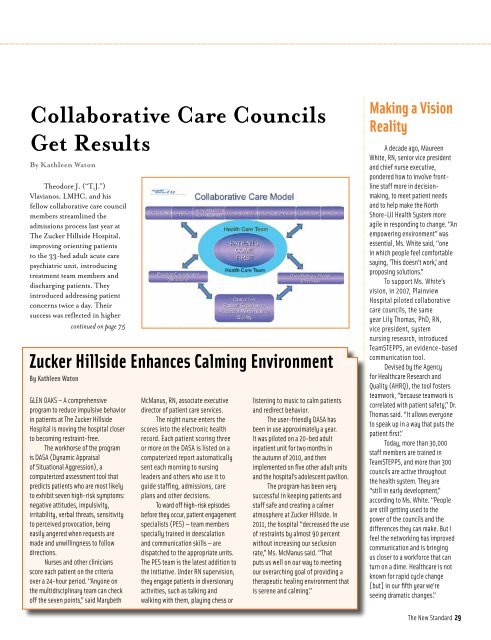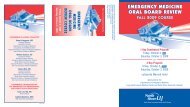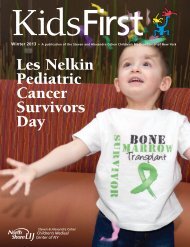Support for Soldiers and Veterans You Gotta Have Heart The Joy of ...
Support for Soldiers and Veterans You Gotta Have Heart The Joy of ...
Support for Soldiers and Veterans You Gotta Have Heart The Joy of ...
Create successful ePaper yourself
Turn your PDF publications into a flip-book with our unique Google optimized e-Paper software.
Collaborative Care Councils<br />
Get Results<br />
By Kathleen Waton<br />
<strong>The</strong>odore J. (“T.J.”)<br />
Vlavianos, LMHC, <strong>and</strong> his<br />
fellow collaborative care council<br />
members streamlined the<br />
admissions process last year at<br />
<strong>The</strong> Zucker Hillside Hospital,<br />
improving orienting patients<br />
to the 33-bed adult acute care<br />
psychiatric unit, introducing<br />
treatment team members <strong>and</strong><br />
discharging patients. <strong>The</strong>y<br />
introduced addressing patient<br />
concerns twice a day. <strong>The</strong>ir<br />
success was reflected in higher<br />
continued on page 75<br />
Zucker Hillside Enhances Calming Environment<br />
By Kathleen Waton<br />
GLEN OAKS — A comprehensive<br />
program to reduce impulsive behavior<br />
in patients at <strong>The</strong> Zucker Hillside<br />
Hospital is moving the hospital closer<br />
to becoming restraint-free.<br />
<strong>The</strong> workhorse <strong>of</strong> the program<br />
is DASA (Dynamic Appraisal<br />
<strong>of</strong> Situational Aggression), a<br />
computerized assessment tool that<br />
predicts patients who are most likely<br />
to exhibit seven high-risk symptoms:<br />
negative attitudes, impulsivity,<br />
irritability, verbal threats, sensitivity<br />
to perceived provocation, being<br />
easily angered when requests are<br />
made <strong>and</strong> unwillingness to follow<br />
directions.<br />
Nurses <strong>and</strong> other clinicians<br />
score each patient on the criteria<br />
over a 24-hour period. “Anyone on<br />
the multidisciplinary team can check<br />
<strong>of</strong>f the seven points,” said Marybeth<br />
McManus, RN, associate executive<br />
director <strong>of</strong> patient care services.<br />
<strong>The</strong> night nurse enters the<br />
scores into the electronic health<br />
record. Each patient scoring three<br />
or more on the DASA is listed on a<br />
computerized report automatically<br />
sent each morning to nursing<br />
leaders <strong>and</strong> others who use it to<br />
guide staffing, admissions, care<br />
plans <strong>and</strong> other decisions.<br />
To ward <strong>of</strong>f high-risk episodes<br />
be<strong>for</strong>e they occur, patient engagement<br />
specialists (PES) — team members<br />
specially trained in deescalation<br />
<strong>and</strong> communication skills — are<br />
dispatched to the appropriate units.<br />
<strong>The</strong> PES team is the latest addition to<br />
the initiative. Under RN supervision,<br />
they engage patients in diversionary<br />
activities, such as talking <strong>and</strong><br />
walking with them, playing chess or<br />
listening to music to calm patients<br />
<strong>and</strong> redirect behavior.<br />
<strong>The</strong> user-friendly DASA has<br />
been in use approximately a year.<br />
It was piloted on a 20-bed adult<br />
inpatient unit <strong>for</strong> two months in<br />
the autumn <strong>of</strong> 2010, <strong>and</strong> then<br />
implemented on five other adult units<br />
<strong>and</strong> the hospital’s adolescent pavilion.<br />
<strong>The</strong> program has been very<br />
successful in keeping patients <strong>and</strong><br />
staff safe <strong>and</strong> creating a calmer<br />
atmosphere at Zucker Hillside. In<br />
2011, the hospital “decreased the use<br />
<strong>of</strong> restraints by almost 90 percent<br />
without increasing our seclusion<br />
rate,” Ms. McManus said. “That<br />
puts us well on our way to meeting<br />
our overarching goal <strong>of</strong> providing a<br />
therapeutic healing environment that<br />
is serene <strong>and</strong> calming.”<br />
Making a Vision<br />
Reality<br />
A decade ago, Maureen<br />
White, RN, senior vice president<br />
<strong>and</strong> chief nurse executive,<br />
pondered how to involve frontline<br />
staff more in decisionmaking,<br />
to meet patient needs<br />
<strong>and</strong> to help make the North<br />
Shore-LIJ Health System more<br />
agile in responding to change. “An<br />
empowering environment” was<br />
essential, Ms. White said, “one<br />
in which people feel com<strong>for</strong>table<br />
saying, ‘This doesn’t work,’ <strong>and</strong><br />
proposing solutions.”<br />
To support Ms. White’s<br />
vision, in 2007, Plainview<br />
Hospital piloted collaborative<br />
care councils, the same<br />
year Lily Thomas, PhD, RN,<br />
vice president, system<br />
nursing research, introduced<br />
TeamSTEPPS, an evidence-based<br />
communication tool.<br />
Devised by the Agency<br />
<strong>for</strong> Healthcare Research <strong>and</strong><br />
Quality (AHRQ), the tool fosters<br />
teamwork, “because teamwork is<br />
correlated with patient safety,” Dr.<br />
Thomas said. “It allows everyone<br />
to speak up in a way that puts the<br />
patient first.”<br />
Today, more than 30,000<br />
staff members are trained in<br />
TeamSTEPPS, <strong>and</strong> more than 300<br />
councils are active throughout<br />
the health system. <strong>The</strong>y are<br />
“still in early development,”<br />
according to Ms. White. “People<br />
are still getting used to the<br />
power <strong>of</strong> the councils <strong>and</strong> the<br />
differences they can make. But I<br />
feel the networking has improved<br />
communication <strong>and</strong> is bringing<br />
us closer to a work<strong>for</strong>ce that can<br />
turn on a dime. Healthcare is not<br />
known <strong>for</strong> rapid cycle change<br />
[but] in our fifth year we’re<br />
seeing dramatic changes.”<br />
<strong>The</strong> New St<strong>and</strong>ard 29




